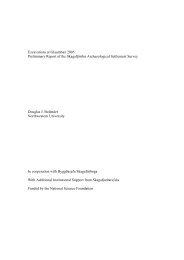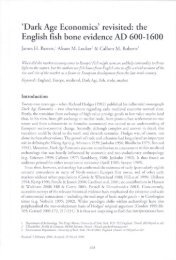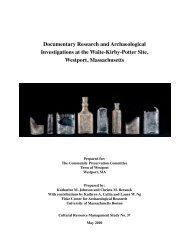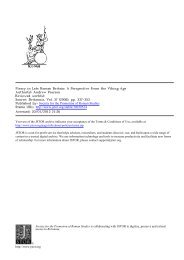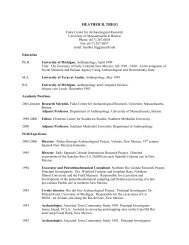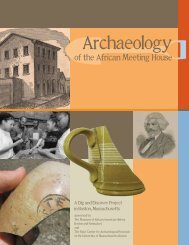archaeological site examination north yard of the ... - Fiske Center
archaeological site examination north yard of the ... - Fiske Center
archaeological site examination north yard of the ... - Fiske Center
You also want an ePaper? Increase the reach of your titles
YUMPU automatically turns print PDFs into web optimized ePapers that Google loves.
VII. R ECOMMENDATIONS<br />
The proposed rehabilitation <strong>of</strong> <strong>the</strong> North<br />
Yard calls for seven changes to <strong>the</strong> area<br />
(Figs. VII-1; VII-2). Each <strong>of</strong> <strong>the</strong>se is listed<br />
below along with comments regarding <strong>the</strong><br />
potential for subsurface disturbance that<br />
each presents.<br />
1) Rehabilitate perennial (parallel) beds<br />
with rose arbors (Fig. VII-2:9).<br />
Garden beds were found to have been present<br />
at this location since <strong>the</strong> early to mid<br />
nineteenth century and were even maintained<br />
when <strong>the</strong> <strong>yard</strong> was landscaped in <strong>the</strong><br />
early twentieth century. The planting <strong>of</strong><br />
shallow-rooted rose bushes in <strong>the</strong>se beds is<br />
not likely to have an impact on <strong>the</strong> wellpreserved<br />
buried A-horizon that is present<br />
approximately 40 cm (16 in) below <strong>the</strong><br />
present ground surface as long as precautions<br />
are taken to prevent planting below<br />
this depth. Construction <strong>of</strong> <strong>the</strong> rose arbor,<br />
however, will impact potentially important<br />
sediments since support posts need to<br />
extend below <strong>the</strong> frost line. Holes for <strong>the</strong><br />
new posts should be <strong>archaeological</strong>ly excavated<br />
in <strong>the</strong> form <strong>of</strong> shovel test pits to mitigate<br />
negative affects on potentially important<br />
<strong>archaeological</strong> deposits in this area.<br />
2) Place a bench at <strong>the</strong> <strong>north</strong> end <strong>of</strong> <strong>the</strong><br />
perennial beds (Fig. VII-2:10).<br />
No subsurface impacts are expected here.<br />
3) Replace existing chain link fence with<br />
new chain link (Fig. VII-2:11).<br />
No subsurface impacts are expected here,<br />
especially if existing posts or post locations<br />
are used.<br />
4) Remove overgrown vegetation from<br />
irregular bed along Greenough Ave (Fig.<br />
VII-2:12).<br />
This work requires <strong>the</strong> removal <strong>of</strong> root balls<br />
from lilacs and o<strong>the</strong>r shrubs. This area is<br />
particularly sensitive since some portions <strong>of</strong><br />
<strong>the</strong> geometric garden bed may be located<br />
here. One <strong>of</strong> <strong>the</strong> early nineteenth century<br />
garden paths should pass through this area<br />
as well. Since significant disturbance may<br />
result from <strong>the</strong> removal <strong>of</strong> plantings, additional<br />
<strong>archaeological</strong> testing is recommended<br />
for this area to identify <strong>the</strong> location <strong>of</strong><br />
<strong>the</strong> garden path and to search for evidence<br />
<strong>of</strong> <strong>the</strong> formal garden. Up to four 1m x 1m<br />
excavation units are recommended for this<br />
area.<br />
5) Restore fruit tree plantings (Fig. VII-<br />
2:13).<br />
The restoration plan calls for <strong>the</strong> removal <strong>of</strong><br />
some existing trees and <strong>the</strong> planting <strong>of</strong><br />
twelve or more apple trees inside <strong>the</strong> sand<br />
walks depicted on <strong>the</strong> 1937 HABS plan.<br />
These activities maintain <strong>the</strong> greatest potential<br />
to disturb <strong>archaeological</strong> deposits. It is<br />
<strong>the</strong>refore recommended to conduct test<br />
excavations at tree removal locations and to<br />
excavate <strong>the</strong> holes for <strong>the</strong> new trees. This<br />
solution will minimize <strong>the</strong> loss <strong>of</strong> potentially<br />
important <strong>archaeological</strong> data across <strong>the</strong><br />
property.<br />
6) Renovate existing lawn (Fig. VII-<br />
2:14).<br />
This activity will not disturb <strong>archaeological</strong>ly<br />
sensitive deposits as long as renovation<br />
does not extended deeper than 40 cm<br />
(16 in).<br />
7) Replace existing wisteria arbor with a<br />
30



